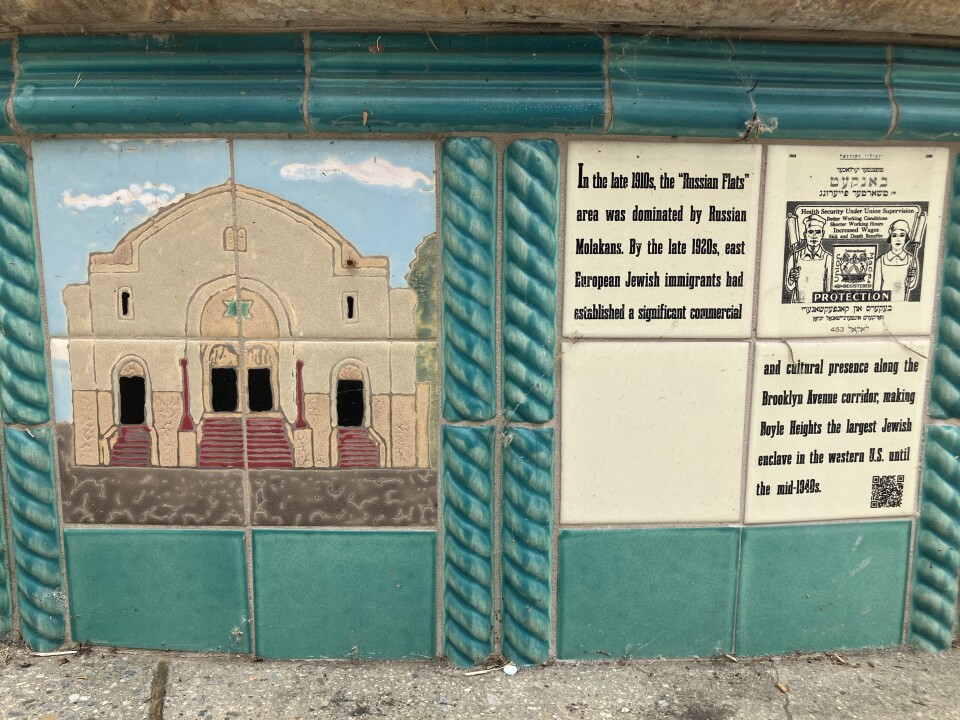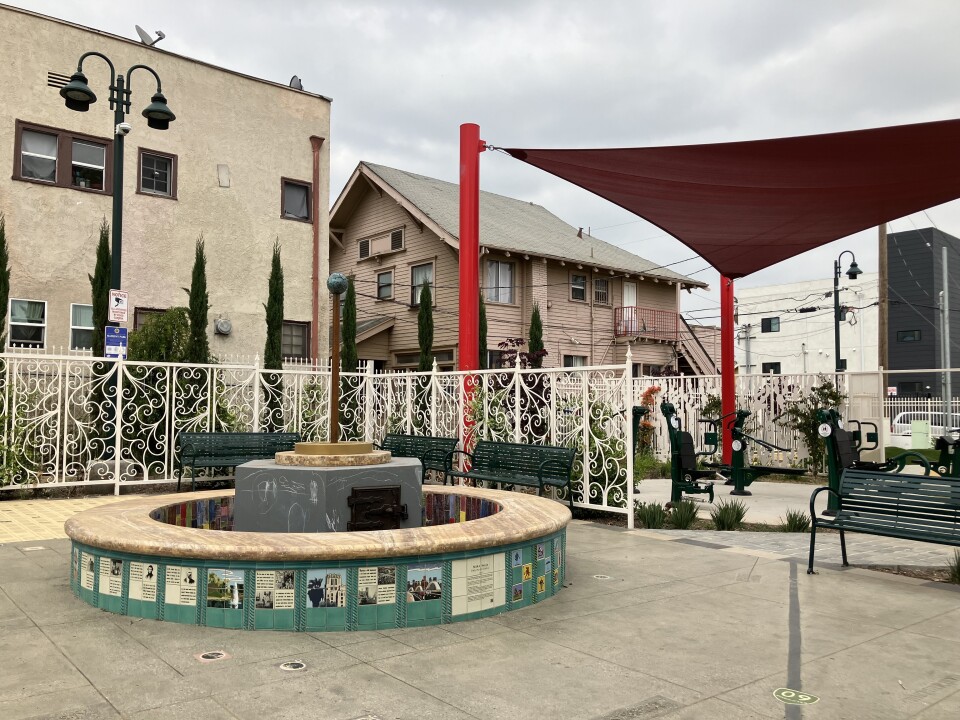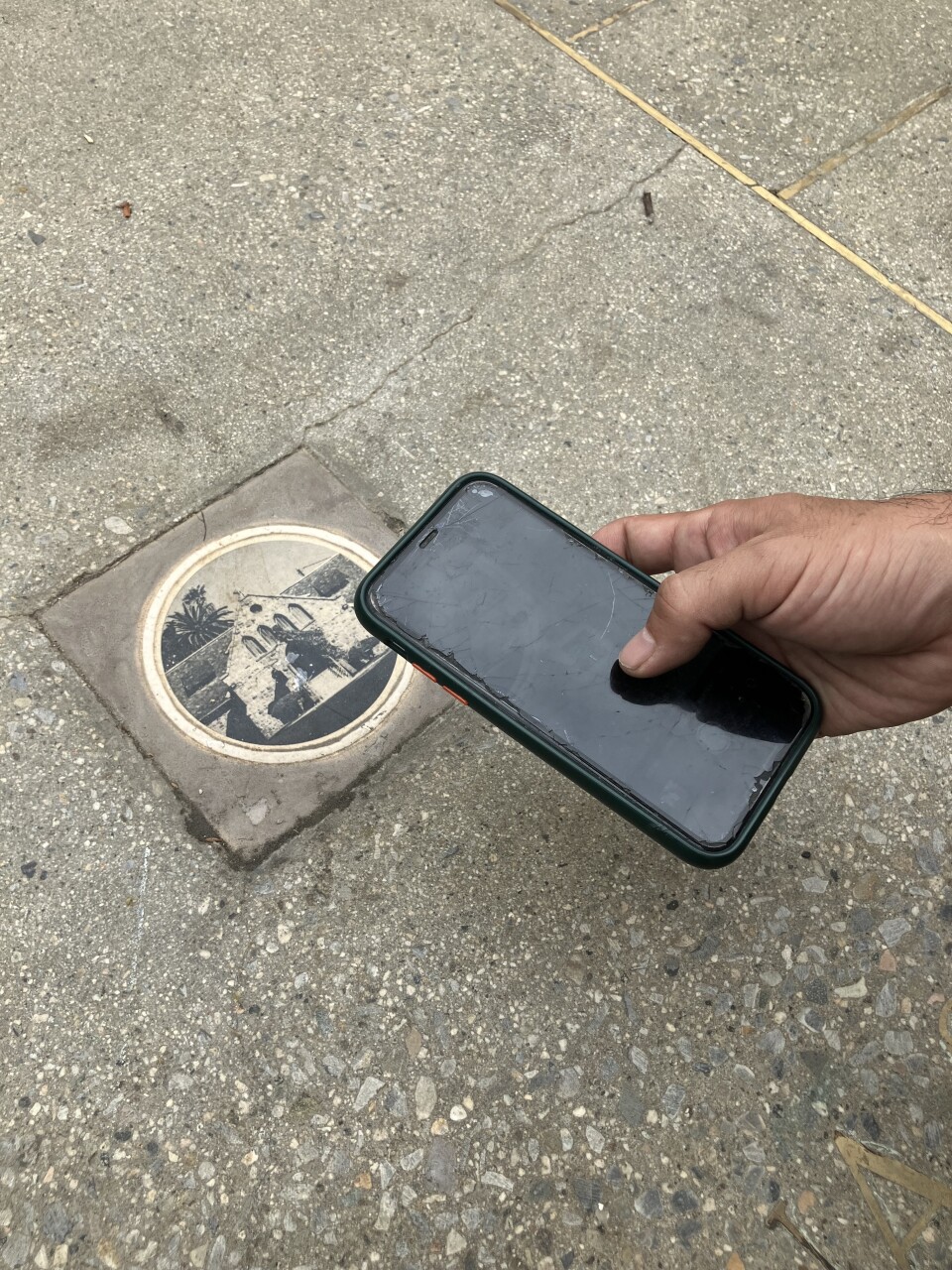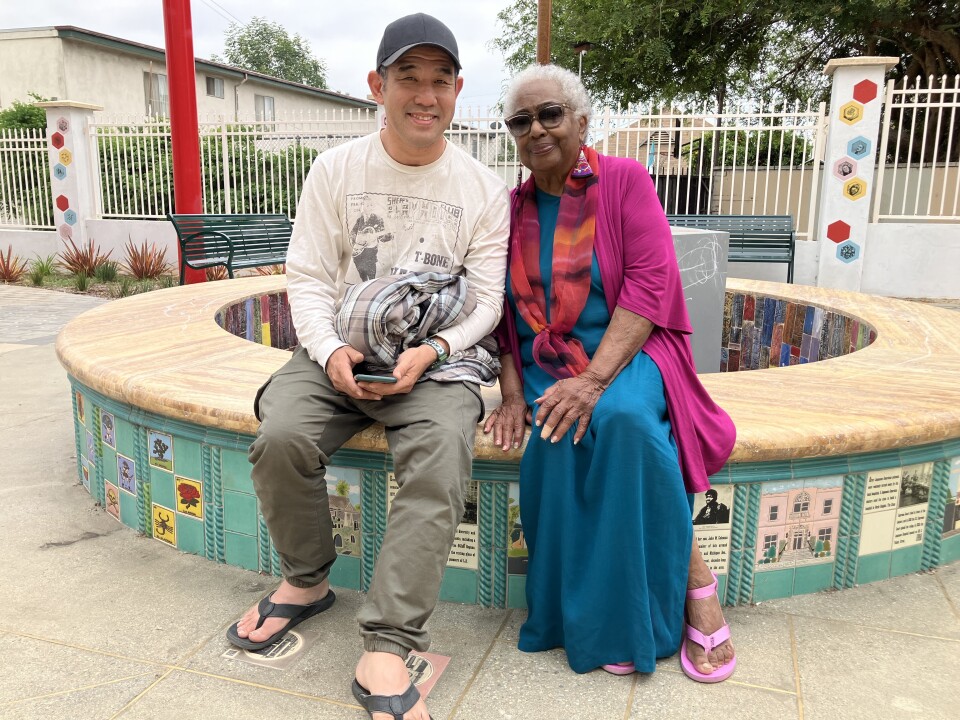Truth matters. Community matters. Your support makes both possible. LAist is one of the few places where news remains independent and free from political and corporate influence. Stand up for truth and for LAist. Make your year-end tax-deductible gift now.
In A New Boyle Heights Park, A Fountain Flows With Local Stories

At first glance, the fountain at the new Mathews Street Park in Boyle Heights looks like any other fountain. It’s round and lined with shiny tiles in tones of aquamarine blue.
But take a closer look and you’ll see that first, there’s no water. Walk around it, and you’ll find that many of the painted tiles depict Boyle Heights landmarks — places like Mariachi Plaza and the Breed Street Shul, along with less-familiar landmarks like the old Japanese Hospital on Fickett Street, and the Mt. Carmel Missionary Baptist Church.
Then, look really closely at the tiles and you’ll see QR codes. Scan them with a cell phone and you’ll find a collection of oral histories from the historic L.A. neighborhood.

This interactive public art project is the brainchild of local artist Mike Saijo, a longtime Boyle Heights resident.
“It’s titled Intersections, about the intersection of the Jewish, Japanese, Mexican, and Black communities in the Boyle Heights area,” Saijo said.
Saijo, who is Japanese American, has long been drawn to Boyle Heights’ past as a haven for people who, due to restrictive covenants, were unwelcome elsewhere in L.A. Over the years. All of these communities put down roots in the neighborhood. It’s a theme that Saijo has explored in his art before.
“I wanted to create a public art version of this concept,” Saijo said.
And that’s what he did.
The pocket park opened in February on the onetime site of a large house that, along with a smaller one behind it, sat abandoned before catching fire. Saijo, who lives across the alley, remembers that day.

“I saw the house catch on from my place,” he said. “I was kind of watching to see what's happening, and they started building this park.”
The city acquired the property and built the park for about $5 million using state Proposition 68 funds. Saijo got involved when he learned there was a callout for a public art feature.
“I said, ‘Oh my God, this is like right behind my studio, like, I gotta apply for this,'” Saijo said.
He applied and received the commission. Working with the Department of Cultural Affairs, he completed the project in about a year.

To design the tiles, he used old photos and hand-drawn sketches, working with several tile shops to produce them. Some of the tiles — like those depicting the iconic stone “kiosko” of Mariachi Plaza, the old Sears retail building and the Breed Street Shul — were intentionally made to look vintage using an old-school production process.
Some of the tiles are on the fountain structure, others are embedded in the concrete around it, which is designed to look like a street grid of Boyle Heights.
A fountain of stories
The heaviest lift was the oral histories. Saijo says he first reached out to the Boyle Heights Historical Society, and then began making connections.
Part of it involved paying visits to “the churches and temples that I've been living next to, but never really talked to anybody there,” he said. “So I had a reason to go over there and start asking questions.”

Saijo said that, altogether, he recorded 25 oral histories from Boyle Heights stakeholders: A pastor whose Creole great-grandfather started the Mt. Carmel church, once a beacon for Boyle Heights’ Black community; the granddaughter of a pioneering female doctor, an immigrant from Japan who treated Japanese patients in Boyle Heights when few doctors or hospitals would; the founding president of the Breed Street Shul Project, a group dedicated to preserving the historic synagogue; the owner of the venerated Candelas Guitars shop, owned by the same Mexican American family for decades.
Saijo worked with an audio professional, Alex Gomez, who worked on production and also provided narration.
There are also poems and stories about more offbeat landmarks, like “El Pino,” the giant pine tree made famous in the movie “Blood In, Blood Out.”
‘Like being in a research library’
Some of the oral histories are not necessarily related to landmarks, but family stories. One recent Friday, Saijo was joined in the park by Shirlee Smith, 87, who grew up in Boyle Heights. She’d just driven out from Las Vegas with her daughter to see the park for the first time, and to hear her story — about her dad, Eugene Pickett.
As Smith took a seat at the fountain, Saijo scanned a nearby tile showing an old photo of kids swimming in a pool. Smith closed her eyes and listened to herself tell the story of how her father and other Black parents protested racist policies at the local playground.

“They protested segregation of the swimming pool at Evergreen Playground, where colored people could only swim on Wednesdays, the day the water was drained and the pool was cleaned,” Smith’s recording goes. “They then took their protests to the Los Angeles City Council. They won.”
After her recording ended, Smith paused for a bit before speaking.
“Amazing,” she said quietly. “Technology. What can I say? I’m wordless.”
Smith added that she grew up swimming in that public pool whenever she wanted to. And she didn’t know until adulthood that her dad had helped make that possible.
“It's just amazing because there is so much information here in this area,” said Smith, who formed her own remembrance project a few years ago, Black Boyle Heights. “I mean, it's like being in a research library.”
Saijo agreed.
“Yeah, that's the idea of creating a place where we can archive all this,” he said.
And as he sees it, not necessarily in a research library, but at the local park.







